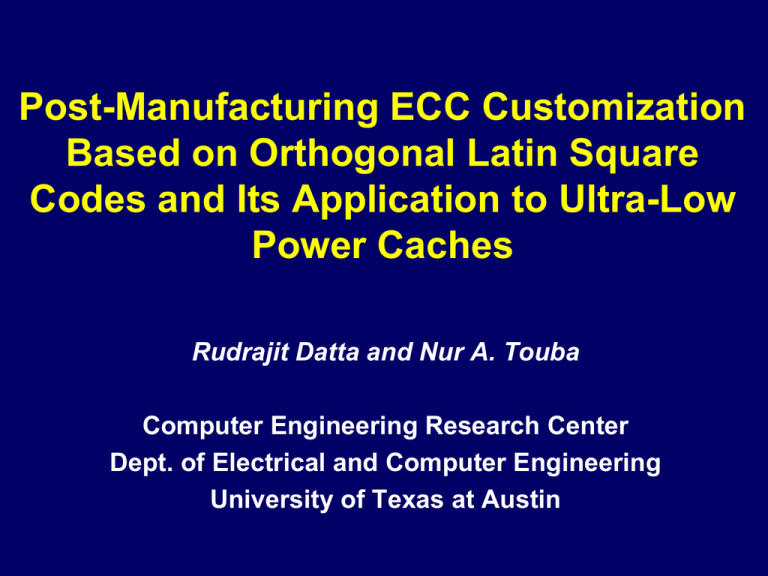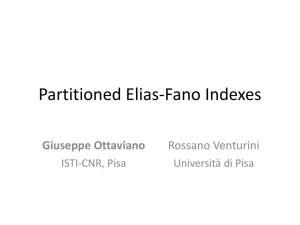ppt - Rudrajit Datta
advertisement

Post-Manufacturing ECC Customization Based on Orthogonal Latin Square Codes and Its Application to Ultra-Low Power Caches Rudrajit Datta and Nur A. Touba Computer Engineering Research Center Dept. of Electrical and Computer Engineering University of Texas at Austin Motivation For memories with high defect rates • Reduce check-bit overhead • Increase reliability Applicable to low voltage caches Agenda Introduction Proposed Approach Application Related Work Orthogonal Latin Square (OLS) Codes Customization Results Conclusion Introduction Tolerate high defect rates for memories • Occurs in memories operating at ultra-low voltages • Expected in future nanoscale technologies – Eg. nanoscale crossbar architectures Conventional method • ECC selected based on – Expected number of maximum defects per word Introduction Data Check Bit Generator cfull Memory Information Bits cfull Check Bits cfull Decoder Corrected Data Observations A priori information available for location of defects • Through post-manufacturing memory tests – Obtain a defect map • Use information to customize code – Reduce check bit storage in memory/caches Proposed Approach Data Check Bit Generator cfull Switch Network cused Memory Information Bits cused Check Bits cused Switch Network cfull Decoder Corrected Data Config. Bits Proposed Approach Customize code by disabling rows of the H-matrix • Possible if modular code used for ECC • Current work looks at OLS codes Configuration Bits 1 0 1 0 Application - Low-voltage Caches Microprocessor voltage lowered while idle • Reduces power Caches and memories susceptible at lower voltages • Unreliable below Vccmin Enable reliable cache operation at lower voltages • At lower voltages use part of cache to store extra check bits Related Work Word-disable and Bit-fix [Wilkerson 08] • Defect map – Identify vulnerable bits • Mitigates only persistent errors • Uses up half of the cache to store extra check-bits Two-dimensional ECC [Kim 07] • Slow • Complicated decoding Multi-bit segmented ECC [Chishti 09] • Orthogonal Latin Square (OLS) code – Single step decodable • High redundancy Key Takeaways Have full ECC on chip • Can handle all defect maps Generate defect map • Disable part of the original code • Reduces check bit redundancy • Retain capability of original code w.r.t the defect map One Step Majority Decoding t-error correctable – information bit copied over 2t+1 times; each an independent copy One copy – bit itself Rest - 2t independent parity equations + corrected di Majority Voter + + di dp cp dq cq ds cs Orthogonal Latin Square Codes Latin Square • m x m array • Row-columns permutation of digits 0,1,…..m-1 Orthogonal Latin Squares • Ordered pair of elements (r, c, s) appear only once m2 data bits, 2tm check bits, t-error correctable [Hsiao 70] Single step decodable Proposed Scheme Implement full OLS code on chip Run memory tests • Generate defect map – At manufacturing time or at boot-time • Identify vulnerable bits Disable rows in OLS H-matrix • On chip-by-chip basis, based on defect map • Correct all erasures PLUS ‘e’ random error in each cache line • Reduce redundancy while providing same reliability Definitions “good row” – for information bit di • Row of OLS H-matrix • No ‘1’ in any other erasure position save bit di − Holds true for all lines In cache “bad row” – for information bit di • Row of OLS H-matrix • ‘1’ in one or more erasure positions apart from bit di • Holds for at least one line of cache “Good Rows” & “Bad Rows” d0 d1 d2 d3 d4 d5 d6 d7 line1 line2 - E - - E - E - - - H-row1 H-row2 H-row3 1 0 1 0 1 0 0 1 0 0 0 1 1 1 0 0 0 1 1 0 1 1 1 0 H-row1 H-row2 H-row3 G B G - B - B G B - B G B G B - Necessary and Sufficient Conditions Tolerate ‘e’ random errors • “good rows” – “bad rows” ≥ 2(e + 1) Original code – t-error correcting • (Max vulnerable bits in any line) + e ≤ t Row Selection Covering problem • • • • Select enough good rows for each information bit di Until constraint is satisfied NP-complete problem Apply heuristics H-row1 H-row2 H-row3 G B “good rows” – -11 “bad rows” G - B - B G B - B G B G B - 11 -1-1 -10 -10 -10 -11 -10 Covering Problem Solve for cache line with maximum erasures first Apply solution to all other cache lines If unsatisfactory, add erasures from one of unsolved lines Repeat until solution fits entire cache Implementation di dp & ctlp corrected di Adjustable Majority Threshold Voter Voter + cp dq & ctlq + cq ctl ds + & ctls cs Experimental Results Results for Word Size of 256 Bits and Bit-Error Rate of 10-3 Check bits for conventional OLS Check bits for customized OLS Avg Max Avg Max Percentage reduction in Max. Check Bits 16 KB 155 224 117 145 35.27 32 KB 166 256 125 148 42.19 64 KB 175 256 134 156 39.06 128 KB 208 256 163 177 30.86 Cache Size (Bytes) Experimental Results Results for Constant Cache Size of 64KB Word Size (Bits) 256 484 Bit-error Rate 10-3 10-4 10-5 10-3 10-4 10-5 Check bits for conventional OLS Avg 175 98 66 295 143 92 Max 256 128 102 396 176 132 Check bits for customized OLS Avg 138 84 64 198 117 89 Max 156 107 68 230 139 115 Experimental Results 64 KB cache, 484-bit word, 10-3 bit-error rate Conclusion Post-manufacturing customization • Reduces large check-bit overhead • Provides requisite reliability • Applicable to systems with high defect rate

